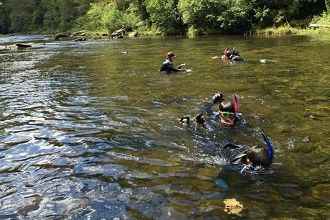Private Scuba › Snorkeling › River Skulking
River Snorkeling Advice
Learning the important river snorkeling tips will help you swim and skulk safely in freshwater currents and across small rapids.
Even so, river snorkeling (also called skulking) does not portray the traditional image of colorful corals and tropical marine fishes found in saltwater oceans.
What Does Skulking Mean for Snorkelers?
There is another underwater world of rivers, creeks, and lakes. Many of them are teaming with freshwater fish and other intriguing aquatic creatures.
This treasure chest of captivating geological interest and mysterious plant life is seldom seen. So, the best way to see it is by river skulking and snorkeling.
Skulking by definition means moving with stealth and hiding sneakily in shelter – like a fish does. It describes the darting movement needed to navigate a river creek or snorkel upstream across small rapids.
You can skulk efficiently by holding on to boulders, moving from one rock to another, or grabbing logs as the river current whips past you. This type of skulking is often done in cold water and it is very physical, much like whitewater kayaking.
Nonetheless, swimming or skulking upstream is a good way to see schools of fishes. They tend to face upstream waiting for food particles drifting in the water column.
10 Tips for Snorkeling a River System
1. Freshwater Snorkeling: Plan Your Swim
The first tip is the most important of all tips for river drift snorkeling activities. Always inform someone (like a relative or a trusted friend who is not on the trip) exactly where you are going.
 They would also need to know what time you expect to return from the excursion.
They would also need to know what time you expect to return from the excursion.
Let them know what emergency procedures they should make if you do not return as planned.
Example of a Swim Plan:
Jack, Suzy, and I are all going river snorkeling at the swimming hole below the bridge at Kent Road.
We plan to return before 3:00 this afternoon, but one of us will call you if our plans change. Please activate the local emergency services if we do not return on time.
River Snorkeling Tips: Plan your swim and then swim your plan!
2. Know the Group Limits
It is important to be aware of the limits and capabilities of all river swimmers. So, it also means that you should understand what previous experience in rescue and self-rescue skills the group have.
You can enroll in a basic water rescue class at your local swimming pool or join a CPR First Aid Course. It could be invaluable if an incident or injury occurs while you’re out skulking the river.
Always Scout Ahead
Scouting the water ahead means stopping at a safe location to evaluate the section of the river beforehand. Do this above and below the water level. Use the scouting technique to identify any potential hazards ahead of swim time.
River Snorkeling Tips: Exit the water and walk around a hazard if you perceive too much risk by traversing the danger in the river.
Ensure that everyone in the group is well prepared for the river snorkeling trip. That means they have had enough food and water before the adventure. Cold water saps energy very quickly.
Proper hydration will help you avoid getting foot cramps while swimming (e.g. muscle spasms). Bringing extra food provisions and a thermos of hot water or tea is easier if your trip is boat or kayak based.
River Snorkeling Tips: Small plastic energy gel packs are fairly easy to store inside your wetsuit.
5. Build Skulking Skills through Experience
The swimming skills and group experience level should be equal to the river and the environmental conditions. It is best to start small on easy rivers. Then you can slowly build your technique and skills through further experience.
Always respect the water! Rivers are dynamic and a living environment. Hence, they can change ‘rapidly’ (pardon the pun).
6. Swim with a Buddy
Never try to snorkel a river system when you are alone. You should always have a snorkeling swim buddy and stay with them in the water. That means if they exit the river then their swimming partner should also get out.
For example, PADI scuba diving training teaches divers to always swim in a pair with a dive buddy or in a group.
7. Wear Protective Equipment
Nowadays there is a lot of protective snorkeling equipment available which helps to reduce injuries in the water. Proper footwear, such as neoprene booties with proper traction, certainly helps to prevent slips and falls on rocks and pebbles.
Besides a good quality snorkel set, you will also need some adequate thermal protection from a high density wetsuit.
8. Practice Snorkeling Skills
There are huge gains to be had by practicing removing and donning your snorkeling mask and swim fins in water. You should avoid panicking if you lose a flipper or your mask starts to fill with water.
Instead, try to focus on retaining your swimming equipment and search for a safe place to reassemble your kit.
9. River Snorkeling Techniques
In general, it is advisable not to snorkel face down around unknown rapids. Instead, keeping your hands out in front of you will help you deflect yourself away from large rocks and boulders.
10. Familiarize Yourself about Hypothermia
Hypothermia can kill! Do not underestimate the seriousness of getting cold in water and how it can affect you. You should also learn how to recognize the effects of hypothermia in other people in the group.
Often, you can reverse 'mild hypothermia' by performing some light exercises on the shore. It helps to encourage blood flow to your limbs and body core. A hot drink can also provide a quick rise in body temperature.
River Snorkeling Safety Tip: STOP any in-water activities immediately if you get too cold.